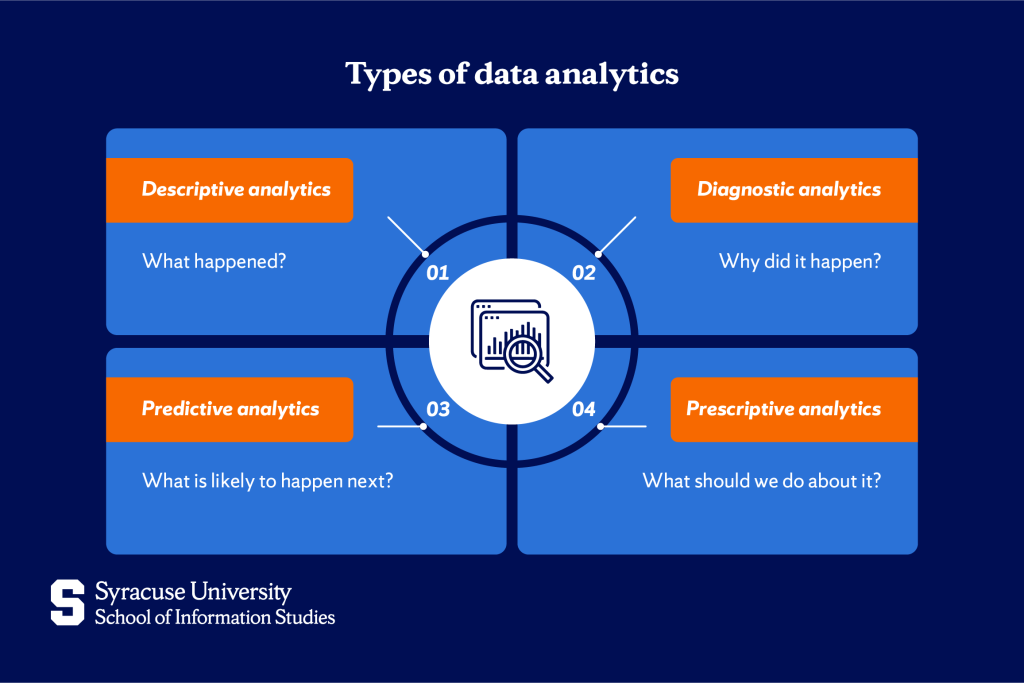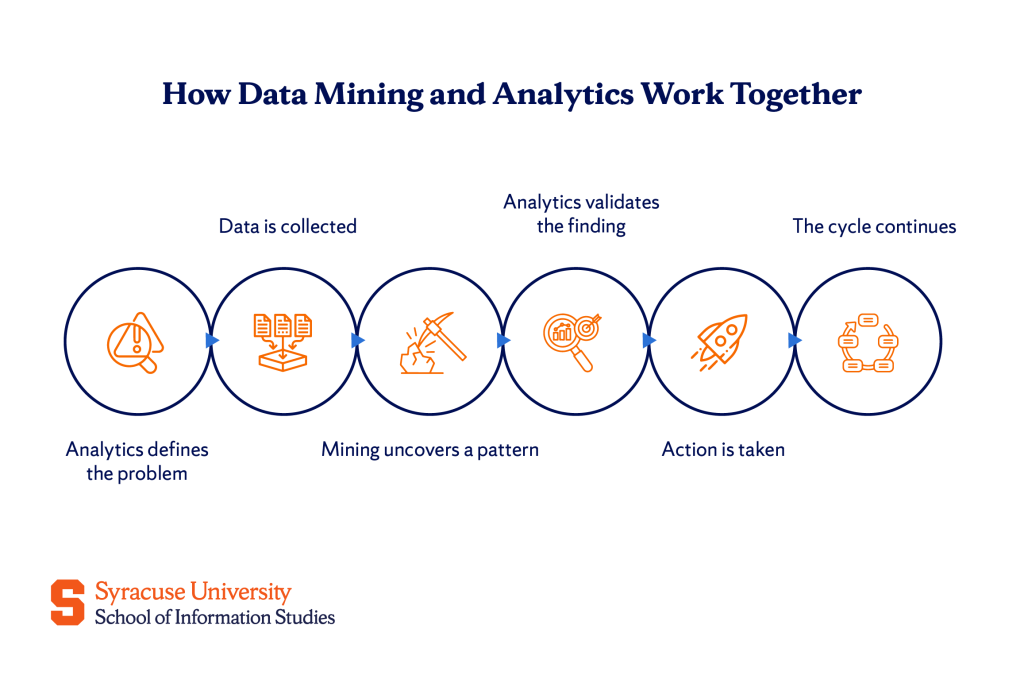Key Takeaways
- Data mining is the process of discovering patterns, trends, or relationships in large datasets using algorithms and statistical methods.
- Data analytics is the broader practice of collecting, cleaning, analyzing, and interpreting data in order to answer questions and guide decisions.
- Data mining and analytics differ in focus, scope, and tools used.
Data is all around us: the information as well as the word itself. We hear about big data, data science, data analytics, data analysis, data mining, and plenty more similar terms in nearly every discussion about technology and business. With so many similar-sounding concepts, it’s no surprise that confusion is common.
That’s why direct comparisons, such as data mining vs. data analytics, are important, especially for students, business managers, and aspiring data professionals who struggle to see what each field actually offers and what it means for their goals.
What Is Data Mining
Data mining is considered as an interdisciplinary subfield of computer science. The word mining is the key to understanding it. Just as miners dig through rock to find hidden resources, data mining involves digging through massive datasets in order to reveal patterns and insights. The goal is discovery, not confirmation.
Data mining is often linked to Knowledge Discovery in Databases (KDD). While the two are connected, they aren’t the same thing. KDD is a full, multi-step process for extracting knowledge from data. Within that process, data mining is the central step that uses algorithms to detect meaningful patterns.
To carry out this discovery, several core techniques are used, including the following:
- Classification: sorting data into predefined categories.
- Clustering: grouping data based on natural similarities.
- Association rules: identifying relationships between different variables.
- Anomaly detection: finding unusual or unexpected patterns.
For example, a streaming service might mine viewing data and discover that users who watch sci-fi thrillers during the week are highly likely to watch historical dramas on weekends. This was not a pattern anyone expected in advance, but once noticed, it could influence content recommendations, acquisition strategies, and targeted marketing campaigns.
What Is Data Analytics
Data analytics refers to the systematic process of examining data to draw conclusions, answer questions, and guide decisions. It encompasses an entire lifecycle that includes collecting, cleaning, modeling, and visualizing information. Within this lifecycle, data mining often provides the discovery step, which then feeds into larger analyses and strategies.
The field of data analytics is typically divided into four main types:
- Descriptive analytics: explains what happened in the past.
- Diagnostic analytics: investigates why something happened.
- Predictive analytics: anticipates what is likely to happen in the future.
- Prescriptive analytics: recommends what actions should be taken.

Using the same streaming service example, if data mining found a surprising viewing pattern, data analytics would address a specific business question, such as “Why did we lose 5% of subscribers last quarter?” Analysts would study user behavior, subscription records, and competitor activity to deliver clear explanations and actionable recommendations.
Key Differences Between Data Mining and Data Analytics
Now that we understand both disciplines individually, it’s easier to examine their practical differences through direct comparison.
A quick comparison table
While data mining and data analytics are closely connected, they differ in several aspects. The table below provides a side-by-side view of their key distinctions.
| Aspect | Data Mining | Data Analytics |
|---|---|---|
| Goal | Discover hidden patterns and relationships not previously known | Answer predefined questions and validate assumptions |
| Scope | A focused stage centered on extracting patterns from datasets | The full data lifecycle, from collection to interpretation and reporting |
| Process | Exploratory, often automated, aimed at uncovering the unexpected | Structured and strategic, aligned to business objectives |
| Data Requirements | Can work with both raw or unstructured data | Typically requires cleaned and well-structured datasets |
| Common Tools | Machine learning algorithms, Python, R | SQL, business intelligence platforms (e.g., Tableau, Power BI) |
| Typical Outcome | New insights that generate hypotheses for further analysis | Actionable recommendations and informed business decisions |
Focus and objective
Data mining and data analytics are both used to learn from data, but they approach it differently. Data mining is exploratory by design. In this sense, the “goal” is discovery: finding the unknowns, surfacing unexpected connections, and generating fresh hypotheses that analysts or researchers can investigate further.
Data analytics, on the other hand, is oriented around confirmation and explanation. Instead of asking “What might be hiding in the data?” analytics typically starts with a question or hypothesis and uses the data to answer it.
Discoveries from mining often become the hypotheses that analytics later confirms or refines. That’s why many experts view mining as a subset of analytics: it serves as the discovery phase within the broader analytical cycle.
Scope of work
Data mining focuses on one concentrated task: applying algorithms to extract patterns from large datasets without prior assumptions about what will be found. It’s often automated, relying on computational methods to surface relationships that humans might not notice on their own.
Data analytics, however, spans the full arc of working with data. It begins with collection and moves through cleaning, modeling, and ultimately communicating results. Mining fits inside this arc as the part that uncovers potential insights. But analytics takes those insights further, validating them, placing them in context, and turning them into actionable recommendations.
In simple terms, data mining is the focused stage where patterns are extracted, while data analytics is the wider process that takes those patterns, combines them with other steps like cleaning and visualization, and turns them into insights that support decisions.
Required skills and tools
The technical foundation of both fields overlaps, but the emphasis varies. Practitioners in both domains often rely on Python or R for scripting, statistical methods for interpreting data, and a strong grasp of databases. Yet the direction they take those skills differs.
In data mining, the toolkit leans toward advanced algorithms and machine learning libraries. Classification, clustering, and anomaly detection require deep familiarity with statistical modeling and the ability to tune models for accuracy. Mining specialists spend much of their time designing or applying these algorithms to unearth new knowledge.
With data analytics tools, the emphasis shifts toward managing and interpreting data in a business context. SQL is a crucial skill for querying and structuring data, while visualization platforms such as Tableau or Power BI are necessary for communicating results to non-technical audiences. Analytics professionals are also expected to translate technical findings into insights that business leaders can understand and act on, which requires strong communication skills.
The distinction, then, is not that one set of skills is “more technical” than the other, but that each applies technical ability toward a different outcome: discovery in mining, and interpretation with recommendations in analytics. In practice, many professionals develop fluency in both areas, allowing them to move from uncovering patterns to explaining what those patterns mean.
How Data Mining and Data Analytics Work Together
Data mining and data analytics are not separate tracks but complementary parts of one process. Analytics frames the questions and directs the investigation, while mining uncovers patterns that can provide the answers. When combined, they form a cycle: ask, discover, verify, and act.
Generally, the process of data mining and analytics working together would look as follows:

- Analytics defines the problem: A company notices customers are leaving and asks, “Why is retention dropping?”
- Data is collected: Teams gather usage records, subscription details, and survey responses.
- Mining uncovers a pattern: Algorithms reveal that customers who skip using new features in the first month are much more likely to cancel.
- Analytics validates the finding: The team checks this pattern across different customer groups to confirm it holds true.
- Action is taken: Marketing creates campaigns to encourage early feature adoption.
- The cycle continues: New data is mined again to find additional reasons customers stay or leave.
Conclusion
Both data mining and data analytics are necessary for organizations to derive real value from their information. They make it possible to work with various types of data.
For students and professionals aiming to work with data in business or technology, understanding how each works is a strong advantage.
At Syracuse University’s iSchool, the Applied Data Science Bachelor’s Degree builds the tools, methods, and ways of thinking needed for both mining and analytics. And if you’re majoring in something else but want the same foundation, the Applied Data Science Minor offers a direct way to sharpen your skills.
Frequently Asked Questions
Is data mining a part of data analysis?
Yes, data mining often serves as a specialized component within the broader data analytics lifecycle, providing the pattern discovery capabilities that fuel strategic analysis.
Can you do data analytics without data mining?
Technically, yes! Many analytics projects focus on answering specific questions using existing knowledge and don’t require pattern discovery, though mining can enhance analytical insights when appropriate.
